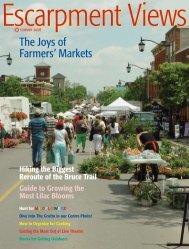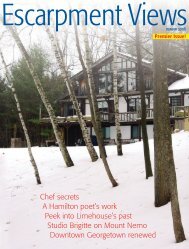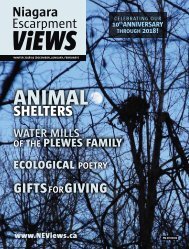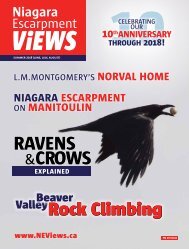Niagara Escarpment Views - Autumn 2016
Create successful ePaper yourself
Turn your PDF publications into a flip-book with our unique Google optimized e-Paper software.
S<br />
tar gazing is also a<br />
viewing event that is<br />
at risk from modern,<br />
urban lifestyles. A<br />
recent study indicates that<br />
two-thirds of the world's<br />
population can no longer<br />
see the Milky Way. Light<br />
pollution impacts the health of<br />
humans, wildlife, plants, and<br />
ecosystems. Ineffective lighting<br />
wastes billions of dollars<br />
each year. Homes, businesses,<br />
and municipalities all have<br />
a role to play in preserving<br />
and enhancing dark skies. By<br />
taking action together, we can<br />
harvest extensive economic<br />
and quality of life benefits.<br />
The <strong>Niagara</strong> <strong>Escarpment</strong><br />
meanders through Canada's<br />
most heavily populated region.<br />
Many southern Ontario<br />
residents have limited or no<br />
views of the natural night sky,<br />
and may have health issues<br />
related to excess artificial<br />
light. Light pollution from<br />
neighbouring properties<br />
can be a source of conflict<br />
in communities too. But<br />
what can we do? Lots! Enter<br />
dark-sky-friendly lighting<br />
and public education.<br />
In 2004, the Municipality<br />
of Northern Bruce Peninsula<br />
declared itself a “Dark Sky<br />
Community” and committed<br />
to retrofit/replace all municipal<br />
lighting to enhance dark<br />
skies. This initiative brought<br />
together a range of individuals<br />
and interest groups working<br />
toward common goals. The<br />
Bruce Peninsula Biosphere<br />
Association accessed funding to<br />
educate and assist homeowners<br />
to upgrade outdoor lighting,<br />
and developed a 52-page<br />
catalogue of dark-sky-approved<br />
lighting fixtures available locally.<br />
Their Bayside Astronomy<br />
Program provides thousands of<br />
summer visitors with wonderful<br />
night sky tours. Their schedule<br />
of events are at bpba.ca.<br />
Dark Sky Preserves<br />
In 2009, the Royal<br />
Astronomical Society of<br />
Canada recognized Bruce<br />
▲ Mike Warkentin of Stokes Bay is an amateur astronomer and a volunteer with Bayside Astronomy Program on Bruce<br />
Peninsula. Here he sets up his telescope on the beach for an evening program at Lion’s Head. PHOTO BY SANDRA J. HOWE.<br />
Peninsula National Park and<br />
Fathom Five National Marine<br />
Park jointly as a Dark Sky<br />
Preserve. In all of Canada,<br />
there are fewer than 20 such<br />
preserves. Others along the<br />
<strong>Niagara</strong> <strong>Escarpment</strong> include<br />
Gordon's Park on Manitoulin<br />
Island and Bluewater Outdoor<br />
Education Centre at Wiarton.<br />
Gordon's Park hosts Stargazing<br />
Manitoulin and many other<br />
dark sky events annually. The<br />
Bluewater Centre is home to<br />
the ES Fox Observatory and<br />
the Bluewater Astronomical<br />
Society, offering public<br />
stargazing and amateur<br />
astronomy programs.<br />
Beyond the joys of<br />
astronomy, dark skies are<br />
critical for environmental<br />
health. Wildlife, especially<br />
nocturnal species, are<br />
negatively impacted as light<br />
pollution disrupts foraging<br />
and movement patterns. Birds<br />
often travel at night using the<br />
stars to navigate; artificial light<br />
disorients them. Over 100<br />
million migrating birds die<br />
annually in North America<br />
due to excessive urban lighting.<br />
28 <strong>Niagara</strong> <strong>Escarpment</strong> <strong>Views</strong> • summer <strong>2016</strong>

















